Online learning is exploding. The market is projected to surpass $400 billion by 2026. Today, almost 70% of U.S. students take at least one online course.
But there’s a big problem.
Many students don’t finish what they start. Online course completion rates can be as low as 15%. A key reason is a lack of engagement. In fact, studies show that 40-80% of online learners are disengaged from their courses.
Simply uploading videos and documents isn’t enough. To create a successful course, you need to captivate your audience. You need to build a learning experience that pulls them in and keeps them coming back.
So, how do you do it? This guide will walk you through the best practices for creating online courses that are not just informative but truly engaging.
Takeaways
To create a successful course, you need a great design that goes beyond just providing information. Here’s how to do it:
- Start with a clear promise. Before each module, tell students exactly what skills they’ll be able to master. This motivates them and provides a clear focus.
- Keep content bite-sized. Break down long videos into short, 10-minute segments. This prevents mental fatigue and makes it easier for students to make progress.
- Include hands-on projects. Don’t just teach theory; have students apply their new knowledge in a practical way at the end of each module. This solidifies learning and builds confidence.
- Build a strong community. Host live Q&A sessions and create a dedicated forum. This human connection reduces isolation and allows students to support each other and ask questions.
- Send automated check-in emails. Proactively re-engage students who fall behind with a gentle nudge and a direct link to where they left off.
1. Start Each Module with a Clear Promise: The “You Will Be Able to…” Statement
Before an adult learner invests their most valuable resource-time-they need a compelling reason. Vague lesson titles like “Introduction to Marketing” create uncertainty and fail to generate excitement. The most powerful way to capture attention from the very beginning is to make a clear, outcome-oriented promise. This shifts the focus from what you will teach to what they will be able to do. This aligns perfectly with adult learning principles, which show that adults are goal-oriented and need to see the immediate relevance of the material to their lives.
By framing your lessons as a set of new skills or abilities they will acquire, you provide a clear roadmap for the module and ignite their motivation to begin. It’s the difference between pointing at a mountain and handing them a map to the summit.
Why It’s a Game-Changer:
- Builds Instant Motivation: It immediately answers the learner’s subconscious question, “What’s in it for me?”
- Provides a Clear Focus: Learners know exactly what to listen for and what they should be able to do by the end, which improves comprehension.
- Adds Perceived Value: A course that promises tangible skills feels more valuable and professional than one that simply lists topics.
How to Implement It:
- At the start of every module, create a short list of 3-5 key outcomes.
- Begin each statement with a strong action verb (e.g., Create, Design, Analyze, Implement, Write, Build).
Example: For a photography course, instead of “Lesson 3: Aperture,” you would use: “By the end of this module, you will be able to:
- Control aperture to create a beautiful, blurry background in your portraits.
- Choose the right aperture settings for sharp landscape photos.
- Use aperture priority mode to speed up your shooting process.”
2. The 10-Minute Rule: Keep Videos Bite-Sized
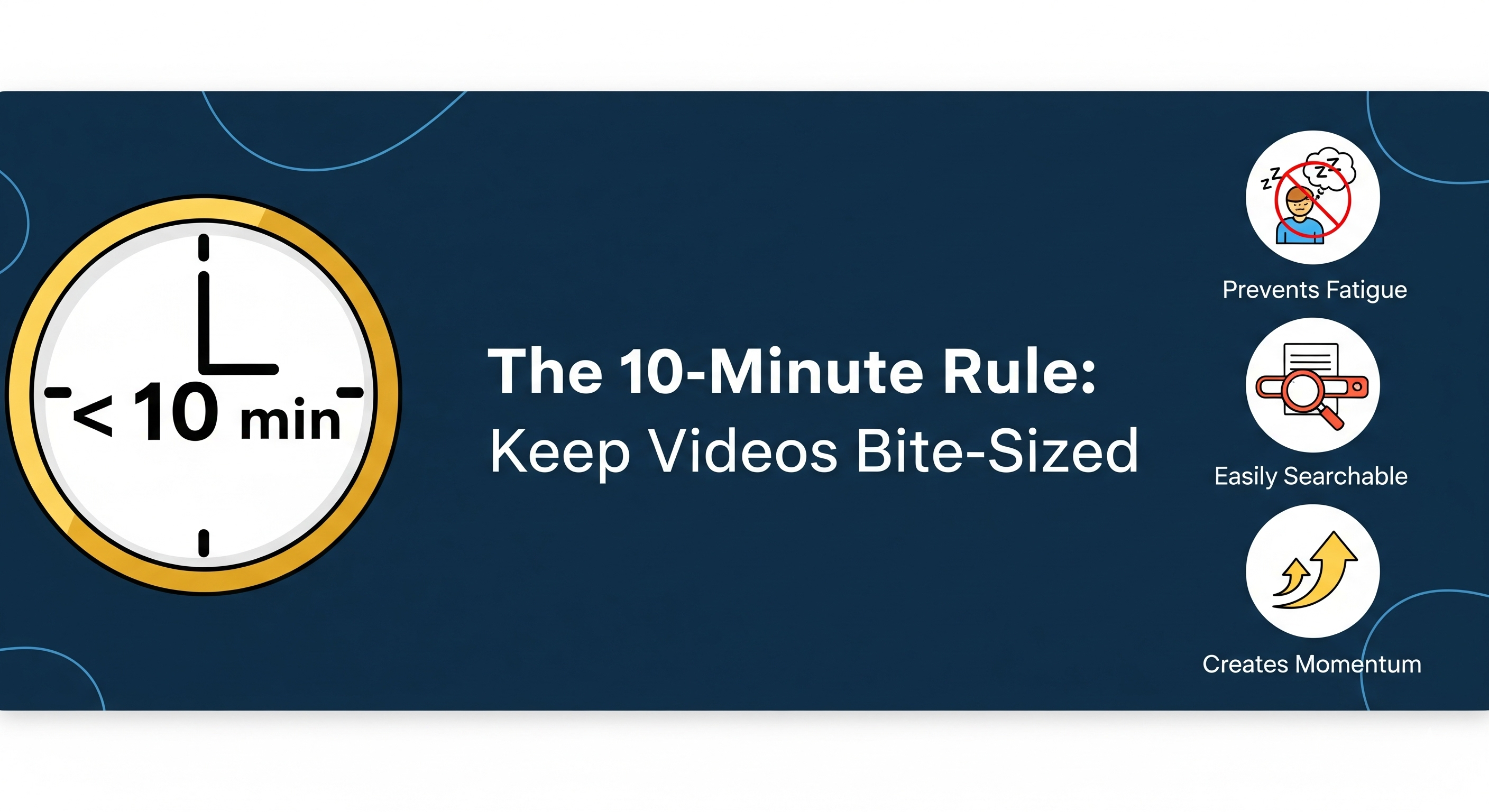
In our hyper-distracted world, a 45-minute video lecture is an intimidating wall of content. This can lead to procrastination and overwhelm. The principle of microlearning suggests that breaking down complex information into small, focused chunks is far more effective for retention and engagement. Shorter videos (ideally under 10 minutes) significantly lower the barrier to getting started. A student is much more likely to think, “I can watch a quick 8-minute video,” than to carve out a full hour.
This approach respects the learner’s time and aligns with how our brains process new information. By focusing each short video on a single, core concept, you prevent cognitive overload and make it much easier for students to absorb, remember, and later review the material.
Why It’s So Effective:
- Prevents Mental Fatigue: Shorter videos help maintain high levels of concentration from start to finish.
- Makes Content Searchable: When a student needs to review a specific topic, it’s easy to find the relevant 7-minute video instead of scrubbing through a long lecture.
- Creates a Sense of Progress: Completing several small videos feels more satisfying and creates better momentum than being stuck in the middle of a long one.
How to Implement It:
- Take your original long lesson plan and identify the 3-5 key sub-topics within it.
- Dedicate one short, focused video to each individual sub-topic.
- Give each video a clear, descriptive title (e.g., “Step 1: Setting Up Your Camera,” “Step 2: Understanding ISO,” etc.).
3. Go Beyond Video: Alternate Your Content Formats
A course that is nothing but a long playlist of videos encourages passive consumption, where the learner can easily zone out. To create true engagement, you need to turn learners into active participants. The best way to do this is by strategically mixing your content formats. This “pattern interrupt” re-engages the brain and forces the learner to interact with the material in different ways.
Alternating between watching a video, completing a worksheet, taking a quiz, and reading a case study caters to different learning preferences. Some people learn best by doing, others by reading. A multi-format approach ensures you connect with a wider range of students and reinforce the learning through multiple modalities, dramatically increasing the odds that the information will stick.
Your Multi-Format Toolkit:
Videos: Perfect for explaining core concepts, showing “how-to” demonstrations, and building a personal connection.
- Downloadable Worksheets & Checklists (PDFs): Excellent for hands-on practice, summarizing key steps, and providing a tangible resource they can keep forever.
- Interactive Quizzes: Ideal for low-stakes self-assessment. They allow students to check their own understanding before moving on.
- Text Lessons & Case Studies: Useful for providing in-depth details, telling stories, and presenting information that students may want to read and absorb at their own pace.
4. From Theory to Practice: End Each Module with a Hands-On Project

Watching someone explain a concept is not the same as understanding it. True learning is solidified when knowledge is applied. Ending each major module or section with a hands-on project is the single best way to bridge the gap between theory and practice. This “capstone project” requires students to synthesize all the lessons from that module and create something tangible with their newfound skills
This process not only cements the knowledge in their minds but also provides a massive confidence boost. Finishing a project proves to the learner that the course is working and that they are genuinely making progress. It transforms them from a student into a practitioner.
The Impact of Application:
- Solidifies Learning: Forces students to retrieve information and apply it in a practical context, which is the key to long-term memory.
- Builds a Portfolio: Students finish the course with a collection of real work they can use to showcase their skills to clients or employers.
- Creates Powerful Motivation: Completing a project delivers a profound sense of accomplishment that fuels their desire to continue with the course.
How to Implement It:
- At the end of a module, create a “Project” lesson.
- Provide a clear, detailed brief outlining the project goal, specific requirements, and submission guidelines.
- Offer a template, a swipe file, or an example of a completed project to reduce uncertainty and provide a helpful starting point.
5. Anchor Every Theory with a Real-World Case Study
Abstract concepts are difficult to grasp and even harder to remember. Our brains are not wired to retain long lists of facts and theories; they are wired to remember stories. A case study or a real-world example is the story that gives your teaching context and meaning. It acts as a mental hook, connecting a theoretical idea to a concrete outcome. This is the crucial step that proves the value of your information and answers the student’s critical question: “That’s a nice theory, but does this actually work in the real world?”
By consistently grounding your lessons in practical examples, you build immense credibility. You show students that you are not just teaching academic fluff, but providing proven strategies that have delivered real results. This helps them visualize themselves applying the knowledge successfully in their own lives and work.
The Power of Storytelling:
- Makes Content Relatable: A story about a struggling small business that used your marketing technique is far more memorable than a list of marketing principles.
- Proves the Validity of Your Teachings: Case studies provide the evidence that your methods work, which builds trust and confidence in your expertise.
- Provides a Blueprint for Action: By analyzing how someone else succeeded, students gain a clearer understanding of how to apply the concepts themselves.
How to Implement It:
- Adopt a “Concept, then Case” structure for your lessons. First, teach the core principle. Then, immediately follow up with a story or example that illustrates it in action.
- Use a mix of examples: feature well-known brands that everyone recognizes, but also include stories of smaller businesses or past students to make the results feel more attainable.
- Break down the case study. Don’t just tell the story; analyze it. Point out the specific steps they took, the challenges they faced, and the key takeaways the student should learn from their experience.
6. Design a Visual Progress Bar to Show Advancement
An online course, especially a long one, can feel like a vast, uncharted territory. This uncertainty can be overwhelming and lead to students losing motivation. A visual progress bar is a simple but profound psychological tool that acts as a map and a motivator. It leverages a principle known as the “goal-gradient effect,” which shows that our effort increases as we get closer to a goal. To show this to your students, you must choose an LMS witha progress bar feature. Klasio shows the progress bar to students while they are completing the courses.
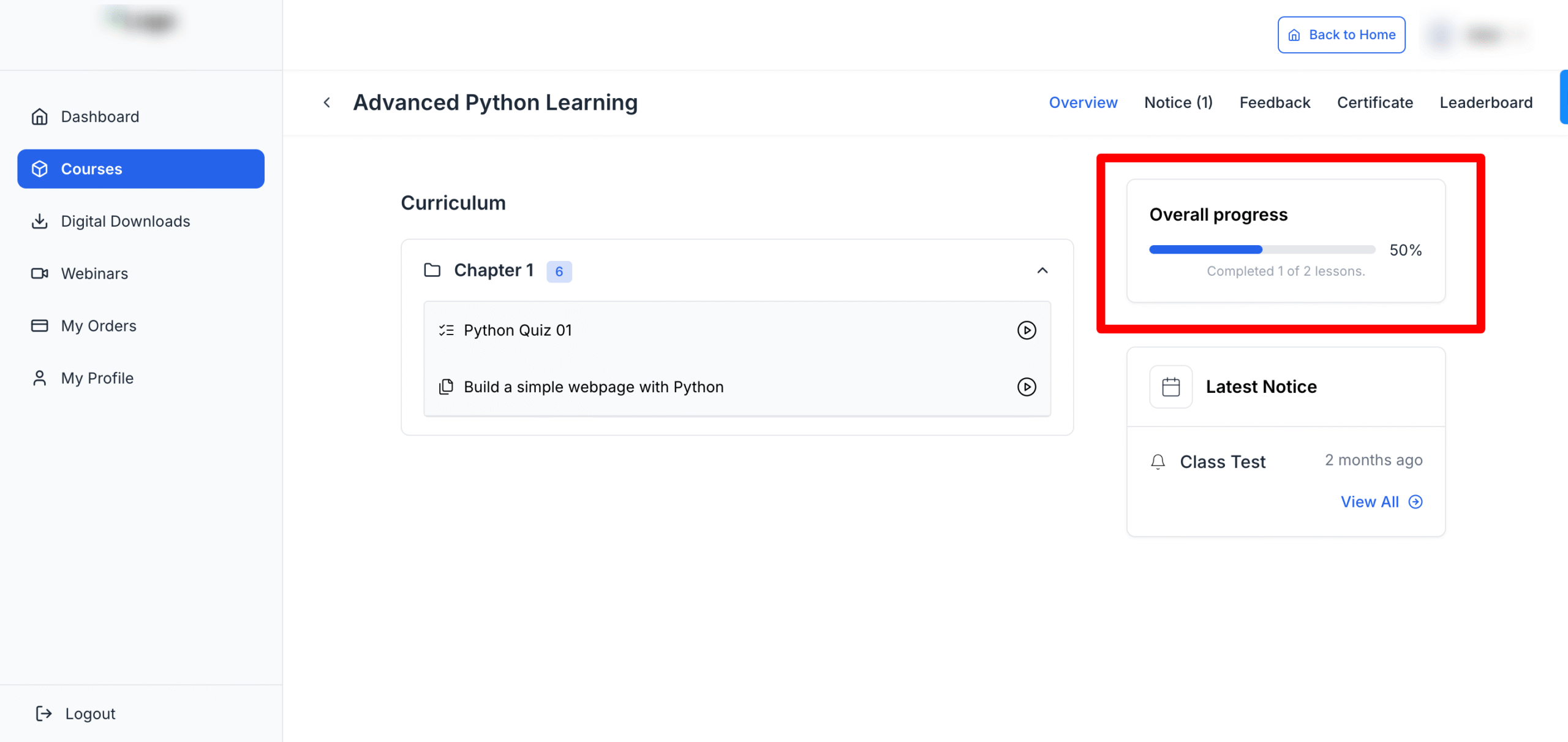
Seeing that bar move from 10% to 25% to 60% provides a constant stream of positive feedback. It gamifies the learning experience, turning it into a quest to reach 100%. This visual cue continually reminds students of how far they’ve come and how close they are to the finish line, which is a powerful antidote to feeling overwhelmed.
Why It’s More Than Just a Bar:
- Provides Constant Reinforcement: Every completed lesson results in a satisfying visual change, creating a mini-reward that encourages them to continue.
- Reduces Overwhelm: It clearly shows the journey is finite and measurable, making the overall course feel more manageable.
- Creates a “Compulsion Loop”: Similar to video games or fitness apps, seeing an incomplete bar creates a natural desire to “close the loop” and see it through to completion.
How to Implement It:
- Most modern Learning Management Systems (LMS) have this feature built in. Ensure it’s enabled and prominently displayed on the student’s main course dashboard.
- Enhance its effect by pairing it with other visual cues, such as a green checkmark appearing next to each completed lesson title.
- Consider adding milestone celebrations. Some platforms allow you to trigger a pop-up message like, “Congratulations, you’re halfway there!” to add another layer of encouragement.
7. Host Weekly Live Q&A or “Office Hours” Sessions
The number one reason students feel disengaged and drop out of online courses is isolation. A course with only pre-recorded content can feel like a lonely, one-way broadcast. Live sessions shatter that isolation. They transform your course into a dynamic, two-way conversation and add a vital human element that pre-recorded videos alone cannot provide.
These sessions create a “community campfire” where students can gather, ask questions, and connect with both you and their peers. This direct access to the expert is a massive value-add that makes students feel supported and heard. It also creates a powerful sense of accountability; students are more likely to keep up with the lessons if they know a live Q&A is scheduled for Thursday.
The Power of the Human Connection:
- Builds a Strong Community: Students realize they are not alone in their struggles and can learn from each other’s questions.
- Provides Real-Time Support: It’s an opportunity to clear up confusion and troubleshoot problems on the spot, preventing students from getting stuck and giving up.
- Increases Course Value: Live access to the instructor is a premium feature that makes your course stand out from the competition.
How to Implement It:
- Choose a consistent day and time for your sessions and stick to it.
- Use accessible platforms like Zoom, YouTube Live, or Facebook Live.
- Collect questions in advance via a Google Form or in the community group to ensure you have material to discuss.
- Always record the session. Make the replay available immediately for students in different time zones or for those who want to review the answers.
8. Use Automated Quizzes for Instant Feedback
Effective learning happens in a tight loop: Action → Feedback → Adjustment. The faster and more frequent the feedback, the faster the learning. Waiting days or weeks for an instructor to grade an assignment creates a broken, ineffective loop. Automated quizzes with instant feedback close this loop immediately, allowing students to assess their understanding in real-time.
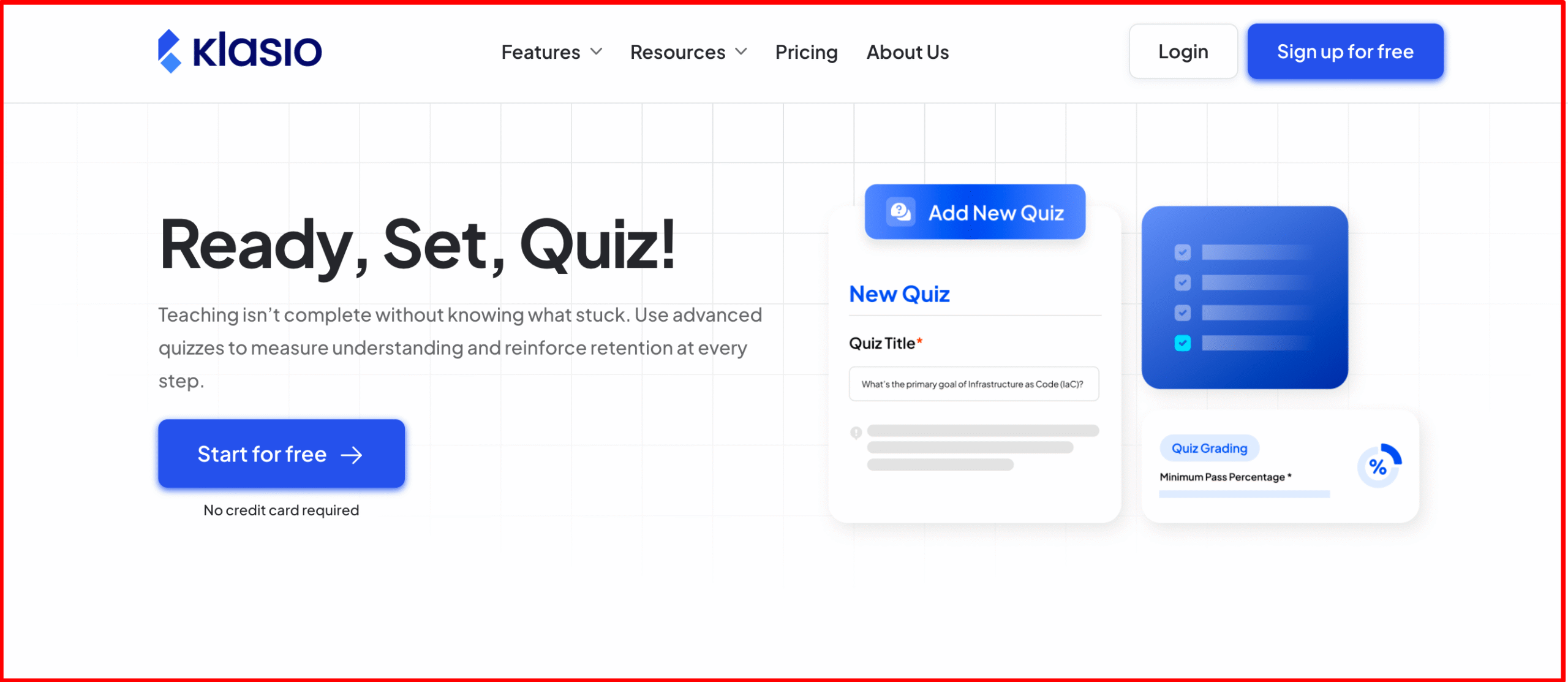
The key to making this a powerful learning tool, rather than just a test, is in the quality of the feedback. Don’t simply mark an answer as “correct” or “incorrect.” Use the feedback to explain why an answer is right or wrong. This transforms a simple quiz from a gatekeeper into a personalized tutor, correcting misunderstandings the moment they occur.
- Why Instant Matters:
- Corrects Misunderstandings Immediately: Prevents a student from building future knowledge on a shaky foundation of misunderstood concepts.
- Reinforces Knowledge: Instantly confirming a correct answer solidifies that piece of information in the student’s memory.
- Builds Confidence: Low-stakes quizzes allow students to safely test their knowledge and gain the confidence that they are ready to move on.
- How to Implement It:
- Place short quizzes at the end of key lessons or modules.
- Focus on the most important concepts; don’t try to test every single detail.
- For every question, write a short explanation for each possible answer. For the correct answer, explain why it’s right. For the incorrect answers, gently explain why they are wrong. This is where the real teaching happens.
9. Create a Dedicated Forum for Community
While live sessions provide instructor-led community, a dedicated forum or group fosters crucial peer-to-peer learning. This is where your course transforms from a simple product into a thriving ecosystem. A community space-whether it’s a private Facebook Group, a Discord server, or a built-in course forum- is the “virtual hallway” where students can connect, collaborate, and support each other on their journey.
This space allows students to ask questions at any time, share their project work for feedback, and celebrate their wins together. Often, another student who was recently stuck on the same problem can provide a more relatable and timely answer than the instructor. This social learning environment creates a powerful sense of belonging and shared accountability.
- Benefits Beyond the Content:
- Reduces Instructor Workload: Students often answer each other’s questions before you even need to step in.
- Provides Invaluable Feedback: Monitoring the discussions gives you direct insight into where students are struggling, helping you improve your course.
- Fosters Long-Term Relationships: The network your students build can be one of the most valuable, long-lasting benefits they get from your course.
- How to Implement It:
- Choose one platform for your community and make it the official hub.
- As the instructor, be an active facilitator, not just a lecturer. Post weekly discussion prompts to spark conversation.
- Encourage students to share their work. Create a culture of constructive, supportive feedback.
10. Send Automated Email Check-ins to Re-engage Students
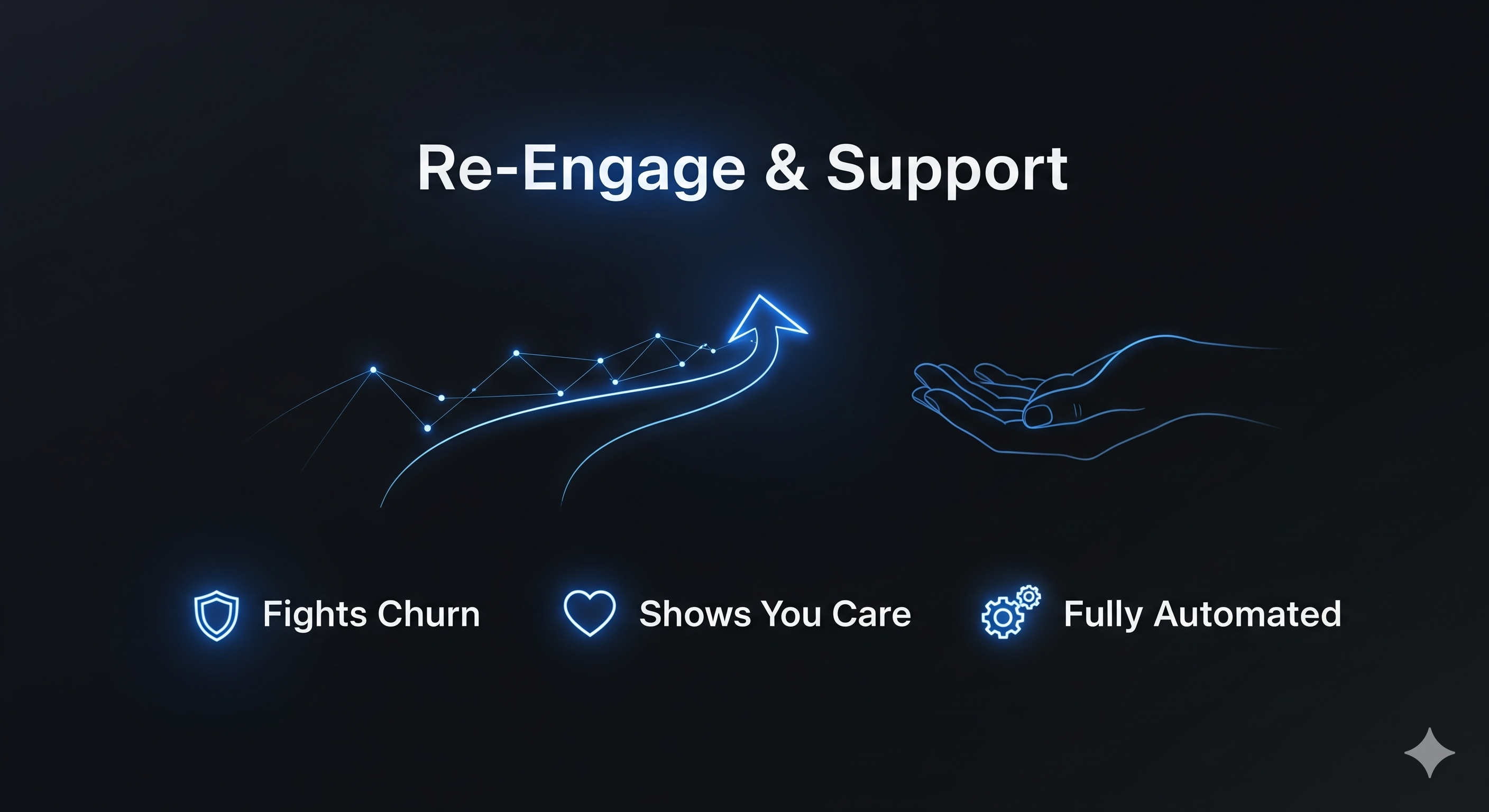
Life is busy. Students who fall behind rarely make a conscious decision to quit; they simply lose momentum and inertia takes over. A proactive, automated email is a simple but incredibly effective tool to combat this. It’s a “gentle nudge” that shows you are paying attention and are invested in their success.
Instead of waiting for a student to disappear completely, you can set up an email that automatically triggers after a specific period of inactivity (e.g., 7 or 14 days). This isn’t about shaming them for being behind. It’s a supportive message designed to break their inertia, remind them of the goal they set when they enrolled, and make it as easy as possible to get back on track.
- The Power of the Supportive Nudge:
- Proactively Fights Churn: It’s much easier to keep a current student engaged than to win back one who has already checked out.
- Makes Students Feel Cared For: A personal-feeling check-in shows that they are not just another number in your system.
- Can Be Fully Automated: This powerful strategy requires a one-time setup and then works for you 24/7.
- How to Implement It:
- Use the automation features in your course platform or email marketing service.
- Keep the tone light, friendly, and encouraging. Use language like, “Just wanted to check in and see how you’re doing,” or “We’ve missed you in the course!”
- Crucially, include a direct link back to the exact lesson where they left off. This removes the friction of them having to remember where they were and makes re-engaging a one-click process.
The line between an online course that students abandon and one they rave about is often drawn by its design. It’s not just about the information you provide; it’s about the experience you create. Here’s a quick comparison of the common pitfalls versus the winning strategies.
Why Engaging Online Course Design Matters?

Great content isn’t enough. Your course design, its structure, and user experience are what turn information into a successful learning journey. Poor design is a key reason students quit.
Here’s why engaging design is critical:
- Boosts Engagement: Intuitive design removes frustration. It helps students focus on learning, not on how to navigate the course.
- Improves Completion Rates: A clear, step-by-step path creates momentum. It motivates learners to cross the finish line.
- Enhances Learning: Smart design encourages active learning, not just passive viewing. This is essential for knowledge retention.
- Builds Trust: A professional, polished look builds credibility. It shows students you are an expert who values their time.
- Increases Satisfaction: An easy-to-use course creates happy students. They leave better reviews and recommend your course to others.
Ultimately, course design isn’t just about looks. It’s the framework that makes your course effective and successful.
Start Making Engaging Courses Today with Klasio
Let’s be honest. That brilliant course idea has been living in your mind rent-free for a while now, hasn’t it? It’s the one that pops up while you’re in the shower, the one you sketch out on napkins, the one you know could genuinely help people.
But then, “reality” hits. The thought of wrestling with complicated software, juggling five different tools for payments and videos, and needing a degree in web design just to get started is enough to make anyone push it to the “maybe next quarter” list.
That’s where Klasio comes in.
We believe sharing your expertise shouldn’t be a technical nightmare. We built Klasio to be the simplest, most intuitive platform to bring your knowledge to the world. Forget the headaches. With our all-in-one system, you can:
- Build with Ease: Our drag-and-drop creator feels less like work and more like play. If you can write an email, you can build a stunning course.
- Focus on Your Content: We handle the boring stuff—payments, hosting, analytics—so you can focus on what you do best: teaching.
- Launch in Record Time: Go from a brilliant idea to a live, money-making course faster than you can brew a pot of coffee. Okay, maybe a large pot of coffee, but you get the idea.
Your audience is waiting. Don’t let confusing tech be the villain in your story. Start building with Klasio today, and turn that “someday” into your day one.
Some Frequently Asked Questions Answered
What is the best course to study in 2025?
The best course depends on your goals, but in-demand fields include artificial intelligence, data science, cybersecurity, and digital marketing.
How to promote online training courses?
Promote courses through a mix of content marketing (blogs, videos), social media, email campaigns, and targeted ads.
What are the demand courses for 2025?
High-demand courses for 2025 are in AI, cybersecurity, data science, cloud computing, and digital marketing.
Which online skill is best in 2025?
The most valuable online skills are often data analysis, coding, cybersecurity, digital content creation, and UX design.
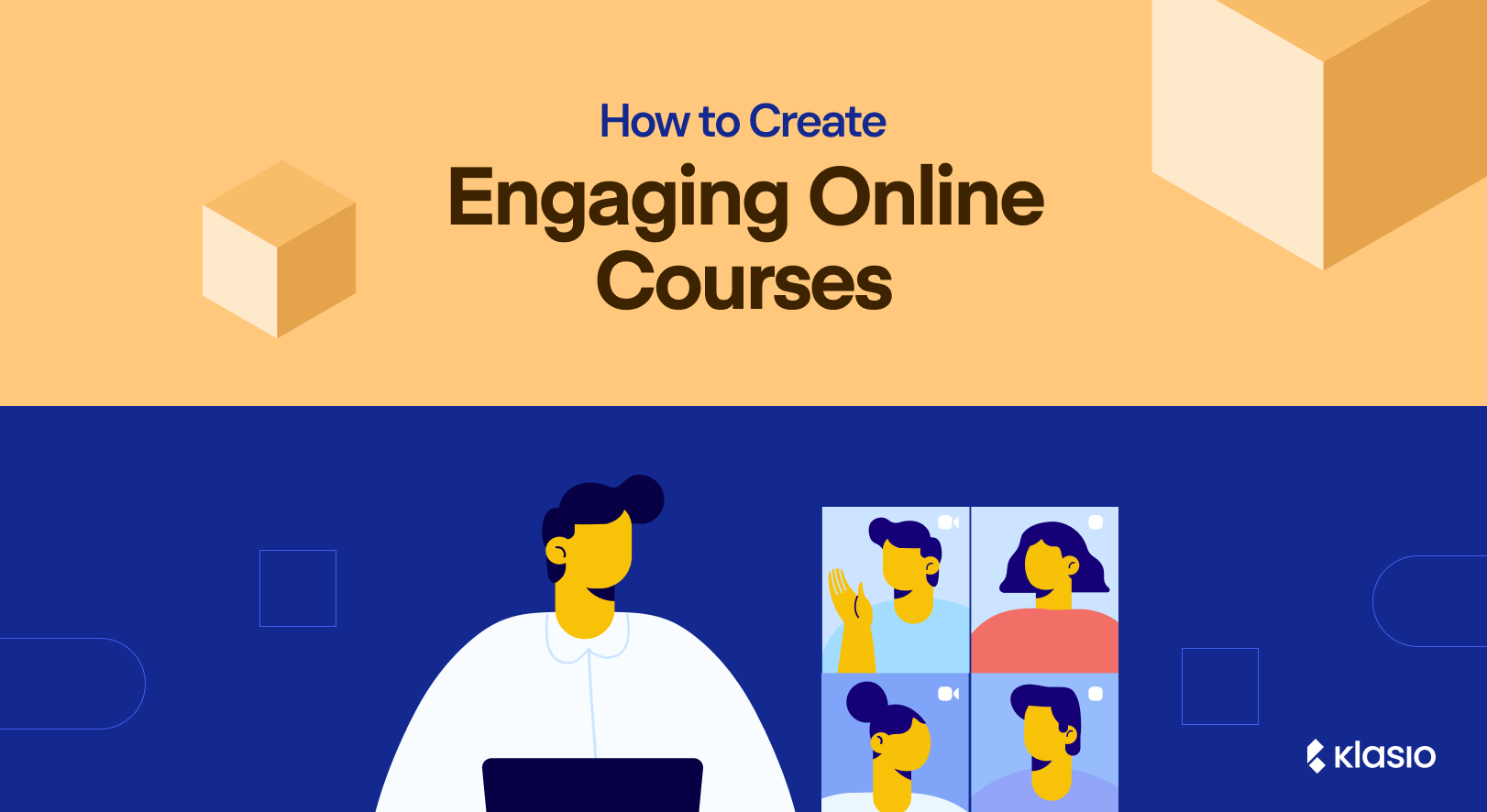
Leave a Reply